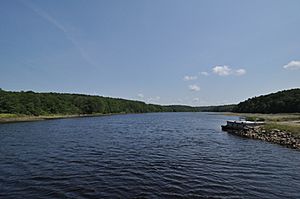Sissiboo River facts for kids
The Sissiboo River is a river found in Digby County, Nova Scotia, Canada. It's a beautiful waterway that winds through the landscape, playing an important role in the local environment.
Contents
What's in a Name? The Sissiboo River's Story
The name "Sissiboo" has a couple of interesting stories behind it. No one knows for sure which one is true!
Mi'kmaq Language: "Seboo"
One idea is that the name comes from the Mi'kmaq people. They are the Indigenous people of this area. Their word for river is "Seboo." It sounds a lot like "Sissiboo," so this is a very likely explanation.
French Legend: "Six Hibou"
Another story comes from early French explorers. Legend says that when a group from Champlain's settlement first discovered the river, they saw six owls. In French, "six owls" is "six hibou." This is pronounced "seese eebou," which sounds exactly like "Sissiboo"! It's a fun story, and other nearby rivers like Moose River and Bear River also have French names.
Where Does the Sissiboo River Start and Go?
The Sissiboo River begins in a series of nine lakes. These lakes are named First, Second, Third, and so on, all the way up to Ninth Lake! They are located near the border with Annapolis County.
Journey Through Communities
From these lakes, the river takes a winding path. It flows through areas that were once busy with lumbering. These include the communities of Weymouth Falls and Weymouth Mills.
Reaching the Ocean
As the river gets closer to the ocean, it reaches Weymouth. Here, the river becomes tidal, meaning its water level changes with the ocean tides. This part of the river is called Weymouth Harbour.
Several roads cross the river. Trunk 1 crosses it in Weymouth. Further downstream, Highway 101 crosses near the fishing community of New Edinburgh. Finally, the Sissiboo River empties into St. Mary's Bay, which is part of the Atlantic Ocean.
How the Sissiboo River Helps Make Electricity
The Sissiboo River has four dams built on it. A dam is a barrier that stops or restricts the flow of water. Three of these dams are very important because they help create hydroelectricity.
Hydroelectric Power
Hydroelectricity is a way to make electricity using the power of moving water. The dams at Weymouth Falls, Sissiboo Falls, and Fourth Lake use the river's flow to generate clean energy for homes and businesses.


